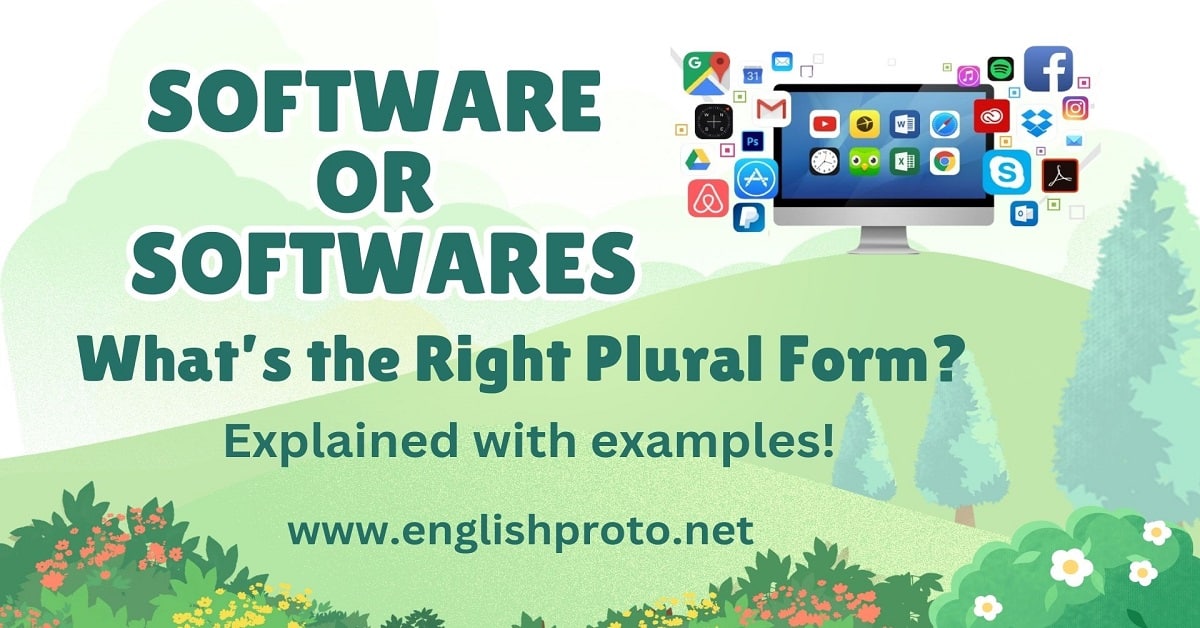Software or Softwares: What’s the Right Plural Form? You’ve probably stumbled upon this question before, maybe even in casual conversation or while drafting a technical email. It might seem like a small detail, but getting it right can make a big difference in how your message is received.
Don’t worry, you’re not alone in this confusion! In this article, we’ll clear up the mystery once and for all, helping you confidently navigate the proper usage. Stick around to discover why software remains the same in both singular and plural forms, and how this knowledge can improve your writing!
Quick Summary
The plural of software is simply software. Unlike most English nouns, software is an uncountable noun, meaning it doesn’t typically have a plural form. It refers to programs, systems, or applications collectively, rather than as individual countable items.
Key Takeaways:
- Software is both singular and plural.
- The term softwares is generally incorrect in standard English usage.
- Using the correct form ensures professional and accurate communication.
Reasons for Confusion
The confusion around the plural of software often stems from several factors:
- Similarity to Countable Nouns:
Many English nouns form their plural by adding an “s,” such as “book/books” or “car/cars.” This pattern leads some to mistakenly assume “software” should follow the same rule. - Non-Native Usage:
In some languages, it’s common to pluralize similar terms. For instance, speakers of French or Spanish might naturally say “softwares,” influenced by their native grammar. - Casual or Regional Variations:
Informal settings, such as online forums or conversations, sometimes feature “softwares.” This usage spreads despite being incorrect. - Misunderstanding the Nature of Uncountable Nouns:
Words like “furniture,” “information,” and “equipment” don’t take an “s” for pluralization. Software belongs to this category, but many aren’t aware of this rule.
Detailed Explanation
What Makes Software Uncountable?
In English, uncountable nouns refer to things that are seen as a whole or a mass rather than individual items. For example:
- Furniture refers to all types of furnishings as a collective.
- Information encompasses all data without specifying quantity.
Similarly, software describes all programs, applications, or systems collectively. While you can count specific items of software (e.g., “a program” or “an app”), the term itself doesn’t change.
Why Does This Matter?
Using software correctly avoids confusion and maintains professionalism, particularly in technical fields. For example:
- Correct: “The software installed on my computer is working perfectly.”
- Incorrect: “The softwares installed on my computer are working perfectly.”
In professional settings, proper language demonstrates expertise and builds credibility.
Common Errors
Here are some frequent mistakes people make when referring to software:
| Incorrect Phrase | Why It’s Wrong | Correct Version |
|---|---|---|
| “The softwares are outdated.” | “Softwares” is not a recognized plural form. | “The software is outdated.” |
| “I purchased new softwares.” | Software is uncountable. | “I purchased new software.” |
| “There are many softwares.” | The plural form doesn’t require “s.” | “There is a lot of software.” |
Synonyms or Alternatives
If you’re looking for variety in your writing, here are some alternatives to consider:
- Applications: Refers to specific software programs.
- Programs: Another term for individual pieces of software.
- Systems: Often used for large-scale or complex software packages.
- Tools: Common in describing utility software.
For example:
Instead of saying, “We need more softwares,” you could say:
- “We need more applications.”
- “We need additional programs.”
Examples in Sentences
To reinforce proper usage, here are examples of software in context:
- Correct Usage:
- “This software is essential for our project.”
- “The company develops security software for enterprises.”
- “We need to update the software on all devices.”
- Incorrect Usage:
- “These softwares are too expensive.”
- “Softwares like this are rare to find.”
Origins and History
The term software originated in the mid-20th century as a counterpart to hardware, which refers to the physical components of a computer. The suffix “-ware” conveys the idea of a collective product, much like “hardware” or “silverware.”
Interestingly, the word was coined to describe the intangible instructions that make machines operate. This collective meaning has persisted, aligning it with uncountable nouns in English.
Conclusion: Software or Softwares
Understanding whether to use software or softwares might seem trivial, but it reflects a deeper grasp of language and professionalism.
By remembering that software is an uncountable noun, like “information” or “furniture”, you can confidently use it in any context. Clear, precise communication is key, and mastering nuances like this sets you apart.
So next time you’re writing an email, giving a presentation, or just chatting about tech, remember: the plural of software is software. No “s” required!



